#Toarcian fossil
Explore tagged Tumblr posts
Text
Lishulong wangi Zhang et al., 2024 (new genus and species)

(Skull of Lishulong wangi, from Zhang et al., 2024)
Meaning of name: Lishulong = Lishu dragon [in Chinese]; wangi = for Wang Zheng-Ju [Chinese fossil hunter]
Age: Early Jurassic (Sinemurian–Toarcian)
Where found: Lufeng Formation, Yunnan, China
How much is known: Partial skull and nine neck vertebrae of one individual.
Notes: Lishulong was an early sauropodomorph. Although many Early Jurassic sauropodomorphs have been named from the Lufeng Formation, Lishulong is the largest one yet found among them, and differs from the others in details of its skull and neck vertebrae. It appears to be closely related to fellow Lufeng sauropodomorph Yunnanosaurus.
Reference: Zhang, Q.-N., L. Jia, T. Wang, Y.-G. Zhang, and H.-L. You. 2024. The largest sauropodomorph skull from the Lower Jurassic Lufeng Formation of China. PeerJ 12: e18629. doi: 10.7717/peerj.18629
103 notes
·
View notes
Text
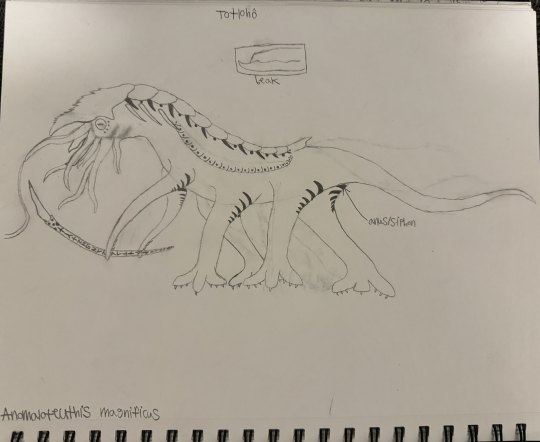
Totlohô
Kingdom: Animalia
Phylum: Mollusca
Class: Cephalopoda
Subclass: Nautiloidea
Superorder: Alysidaceratoidea
Order: Paratetrapoda
Superfamily: Cotylopodoidea
Family: Cotylopodidae
Subfamily: Anomaloteuthiinae
Genus: Anomaloteuthis
Species: A. magnificus (”magnificent unusual squid”)
Ancestral species: possibly Plectronoceras cambria
Temporal range: Early Jurassic (Toarcian) to Early Cretaceous (Hauterivian) (180 - 130 mya)
Information:
While humans have long seen themselves as the first and only sapient species to inhabit their planet, in all truth, there existed another in Xenogaea several hundreds of millions of years ago, one whose legacy can still be felt throughout the region untold eons later in their bizarre ruins and artifacts: the Totlohô-tu-Tẋusko/Tẋusko-tu-Totlohô (IPA: /to̞t͡ɬo̞hɔ tu t͡ʃusko̞/ OR /t͡ʃusko̞ tu to̞t͡ɬo̞hɔ/, meaning "ancestor of (the) architect"), better known as simply the Totlohô (/to̞t͡ɬo̞hɔ/, simply meaning "architect").
As soft tissues of this species have only rarely been preserved, and hard tissues consist only of armor plating and beaks, their size and general appearance alone must be inferred purely based on known proportions from living relatives, other members of the aberrant nautiloid clade Alysidaceratoidea, known more colloquially as the shrikehounds. The most reliable size estimate places them at around 12 feet long, 6-7 feet tall, and weighing close to 600 lbs. The appearance of these creatures, based on ancient stone murals, would seem to suggest that they were centaur-like in build, sporting six main limbs along with a menagerie of smaller tentacles around the face, which housed a long, narrow beak with a noticeable underbite. The exact coloration of this species isn’t known, though as murals exist which depict them, it can be inferred that they might have had a similar coloration pattern to living nautili, with a creamy-colored body and eyes with an earthy red shell and head piece.
Living shrikehound species are not particularly vocal, with only the paratetrapods having an analogue to proper vocal cords. This species was presumably vocal in some capacity, though the exact vocalizations cannot be deduced. It has been suggested that like their living relatives, they might have been able to produce clicks, grunts, warbles, rumbles, belches, screeches, and shrieks. It has been suggested, however, that they may have convergently evolved chromatophores like some of their living relatives and may have had a primarily visual language instead, one which has not, as of yet, been decoded.
Much of these organism's general biology is not known conclusively. Most evidence points to a carnivorous diet, consisting mainly of small dinosaurs/paravians, but also other terrestrial nautiloids, small mammals, and a bizarre group of terrestrial acanthodians known as coelospondyls. Though the exact place where they first evolved has yet to be conclusively found, fossilized beaks first appear in the Matansitra Formation in the southwest of the Isle of Perils, though later formations across the entire archipelago show that almost every habitable landmass sported a population of these creatures at one point. Dubious material from areas outside the archipelago, including what is now China and Australia, suggests they may have eventually left the archipelago at some point as well. At their peak during the Kimmeridgian age of the Late Jurassic epoch roughly 150 millions years ago, their population size was likely upwards of 40 million. Very little (if anything) can be inferred about their reproductive biology, though murals would seem to suggest that courtship and copulation was a very long, drawn-out process, treated almost as an art form unto itself. From their closest relatives, it can be inferred that the males, using a modified tentacle, deposited sperm into a small groove on the female’s underside, where it could be absorbed and used to fertilize the eggs. Their clutch size is believed to have been anomalously small compared to other species in their clade, possibly no more than 10 eggs at a time. The young appear to have matured at a similar rate to human young, if not slightly faster. Sexual dimorphism does not appear to be a prominent trait within their species.
Not much can be inferred about the behavior of this species from what remnants have been found, though it can be inferred that they were likely highly social creatures with complex social structures. They appear to have engaged in agrarianism and the farming of other animals in their later stages of societal development, as evidenced by a high correlation in dump beak remains found near dump sites for animal bones and shell, and even built cities. Murals would seem to suggest Totlohô society was ruled by a class of elders, the oldest respective members of their society, while the youngest members formed the work force. Song and dance appear to have been ways to bond with one another, and spirituality played a large part in their society’s function. Warfare appears to have been an isolated phenomenon in their society and frequently on a much smaller scale than as seen in humanity, though there exists some evidence of widespread warfare in the later years of existence. Even in their later stages, when they evidently had significantly advanced technology (or, as the more conspiracy-minded would suggest, magic of some kind), the Totlohô still preferred to build their homes out of stone.
During the later stages of their existence, the Totlohô appear to have dabbled in what appears to be highly-advanced technology or potentially even magic of some kind, as evidenced by massive, seemingly Totlhômade, carved, levitating stones covered in glyphs. In a place known as the Square Chasm (picture below, artwork by Dipfruit), a reportedly supernatural space some weary jungle travelers have stumbled upon near a triple-forked river, one of these stones appears to have formed a perfectly square-shaped pocket dimension around itself, where gravity itself appears to bend to the stone’s whim.

Fossilized beaks and hard shells are really the only physical parts of these creatures to have been preserved, and they are the only indication of their existence outside of aforementioned ruins and murals. Their written languages have yet to be decoded, and there are believed to have been several thousand at a given time. What exactly led to their extinction has yet to be conclusively revealed, though murals seem to suggest that, from their perspective, supernatural forces may have been at play, with recurrent imagery of what appears to be demonic figures showing up across several murals. Another recurrent image in these murals is a white bird-like creature with horns, which some have suggested may be related to the mythical white bird seen in Xenogaean mythology, which was said to herald the apocalypse. While some have suggested that these murals may have been painted by one of the last Totlohô, who had simply gone insane from isolation and began painting their hallucinations, others suggest that there might be a grain of truth in these murals, perhaps a war of apocalyptic scale which engulfed the entire species, the demagogues fueling it being portrayed as demonic figures. What this doesn’t explain, however, are the high number of artifacts which appear to be made from an unknown metallic substance, one which is highly durable and in near-pristine condition hundreds of millions of years later. This substance, referred to colloquially as “anomalous tungsten”, is paradoxically lightweight yet durable with a high melting point, seemingly higher than almost any other known metal or metalloid. As this metal has not been found anywhere on Earth or even in any known compounds on Earth or another planet, this begs the question of how and where the Totlohô obtained this substance, leading to a wide menagerie of conspiracy theories, with everything from extraterrestrials to divine beings being suggested as the source from which they obtained this material. Whatever the case, those who have studied the artifacts have claimed to have had vivid dreams where they spoke to the Totlohô shortly after contact. Perhaps this is just a form of confabulation or merely even group hysteria, but nonetheless, it would appear that even long after the Totlohô have left this world, their legacy still manages to touch the human spirit. Finally, they appear to have domesticated a species of coelospondyl, Platycephale aridus, the so-called “flat-faced coelospondyl” (1st picture below, artwork by me), and another species of shrikehound, which is currently unnamed (2nd picture below, artwork by me). These appear to have been utilized as livestock animals.


#novella#speculative evolution#fantasy#scifi#scififantasy#speculative biology#speculative fiction#speculative zoology#worldbuilding#creature art#sophont#sci fi creature#creature design#fantasy creature#creative writing#creature#scifi worldbuilding#fantasy worldbuilding#nautiloid#nautilus#cephalopod#mollusk#cephalopods
18 notes
·
View notes
Text
May Readings
Media Articles and Blog Posts (Not Everything, Just the Interesting Ones):
Arizona's Petrified Forest is Changing What We Know About the Dawn of the Dinosaurs by Shaena Montanari
Battling a Hungry Beetle, This Mohawk Community Hopes to Keep Its Trees -- and Traditions -- Alive by Nicole Dainty, Hannah Daramola, Madison Eldridge, and Nadja Radakovic
Building Britain's Borders by Marc Di Tommasi
Call of the Liar by Carly Cassella
Captive-Bred Axolotls Were Successfully Introduced to the Wild. Can This Work for Other Species? by Kiley Price
Could This Arizona Ranch Be a Model for Southwest Farmers? by Samuel Gilbert
Feather Forensics Offers a Way to Root Out Poachers by Jude Coleman
The First Volcanic Eruption to be Photographed? by David Pyle
Fossil Folklore: Echinoderms by Paul D. Taylor
Fossils Reveal Enormous, Crocodile-Like Reptiles Survived for Millions of Years Longer Than Previously Thought by Lillian Ali
How Can You Tell if Soil is Healthy? Just Listen to It by Ayurella Horn-Muller
In the Netherlands, Anyone Can Turn a Slice of Sidewalk into a Garden by Klaus Sieg
It Used to Spell Death and Destruction for Ecosystems. Now, It Can Be the Key to Saving Them by Anna Gibbs
Martin Crusius' Armchair Voyage by Richard Calis
Mobile Home by Steven Bedard
The Otsu Incident by Mathew Lyons
Pulled From the Deep by Clare Fieseler
The Record of Natural Disasters on the Coinage of Imperial Rome by David R. Sear
Russians Recover Lost Ice Station by Theodore Shabad
Scientists Identified the Oldest Star Chart in Existence by Elizabeth Rayne
Scientists Think They Can Save the 'Asian Unicorn' -- If It's Not Already Extinct by Emma Frederickson
Slow-Speed Chase by Krista Langlois
Smuggling Under the Cover of Plague by Dabeoc Stanley
The Sounds and Songs of Iceland's Melting Landscape by Karen McHugh
Unearthing the Mysteries of Hawai'i's Ancient Agriculture by Sarah Lohman
Walled Off by Phoebe Weston
We Need to Remember Problems We Solved by Laura Helmuth
Whale Sharks' Low-Oxygen Advantage by Claudia Geib
What a Whale Does Not See by Marina Wang
What Deep Cuts to NOAA Mean for U.S. Fisheries by Meg Wilcox
Why Most No-Till Agriculture Is Not Actually Regenerative by Nate Powell-Palm
Wildlife, Not Livestock: Why the Eastern Shoshone in Wyoming Are Reclassifying Buffalo by Taylar Dawn Stagner
World's Earliest Depiction of Volcanic Eruption by Kathleen Micham
World's Smallest Volcano Discovered in Colombia by Erik Klemetti
Scholarly and Scientific Articles:
"Ancient Fossil Discoveries and Interpretations" by Adrienne Mayor
"Bioelectrical Synchronization of Picea abies During a Solar Eclipse" by Alessandro Chiolerio, Monica Gagliano, Silvio Pilia et al
"Conditions of Life at Great Depths in the Ocean" by August Krogh
"Early History of the Great Red Spot on Jupiter" by W. F. Denning
"An Ichthyosaur Carcass-Fall Community from the Posidonia Shale (Toarcian) of Germany" by Daniel G. Dick
"Lightning Teeth and Ponari Sweat: Folk Theories and Magical Uses of Prehistoric Stone Axes (and Adzes) in Island Southeast Asia and the Origin of Thunderstone Beliefs" by Adam Brumm
"Movie Footage of the Activity of Parícutin Volcano, Michoacán, Mexico, 1945-1952" by Carl Fries, Jr., Kenneth Segerstrom, Robert I. Tilling, et al
"The Origin of Jupiter's Great Red Spot" by Agustín Sánchez-Lavega, Enrique García-Melendo, Jon Legarreta et al
"A Phenomenon Discovered While Imaging Dolphin Echolocation" by Jack Kassewitz and Michael Hyson
"Radiocarbon and DNA Evidence for a Pre-Columbian Introduction of Polynesian Chickens to Chile" by Alice A. Storey, José Miguel Ramírez, Daniel Quiroz, et al
"Reconstructing Tropical Arctic: Greenland's Late Triassic Past" by Jennifer McElwain, Marlene Hill Donnelly, and Ian Glasspool
"The Selective Geography of Volcanism in Oral Traditions" by Leigh Franks, Patrick D. Nunn, Adrian McCallum
"The Significance of Anomalocaris and Other Radiodonta for Understanding Paleoecology and Evolution During the Cambrian Explosion" by Gaëtan J.-M. Potin and Allison C. Daley
"Whale-Fall Ecosystems: Recent Insights into Ecology, Paleoecology, and Evolution" by Craig R. Smith, Adrian G. Glover, Tina Treude et al
Short Stories
"Nightfall" by Isaac Asimov
0 notes
Text
Un fossile de blatte vieux de 180 millions d'années découvert au Royaume-Uni
See on Scoop.it - EntomoNews
Cette blatte pourrait nous offrir des informations sur les stratégies de survie adoptées par les insectes dans des environnements extrêmes.
par Brice Louvet
31 octobre 2024, 20 h 00
------
NDÉ
L'étude
A new cockroach (Blattodea, Rhipidoblattinidae) from the Toarcian (Lower Jurassic) of Alderton Hill, Gloucestershire, UK, and the earliest likely occurrence of aposematic colouration in cockroaches - Swaby - 2024 - Papers in Palaeontology, 24.10.2024 https://onlinelibrary.wiley.com/doi/10.1002/spp2.1598
Traduction
Nous décrivons la septième espèce valide de blatte, Alderblattina simmsi gen. et sp. nov. provenant de strates riches en insectes qui témoignent de l'événement anoxique océanique du Toarcien (T-OAE). Le T-OAE représente une période de réchauffement global extrême et de changement environnemental qui a entraîné des pressions paléoécologiques et des changements évolutifs dans les écosystèmes marins et terrestres.
Pour la première fois, nous présentons ici des preuves que cet événement pourrait également être à l'origine de l'évolution de la coloration aposématique, un moyen de dissuasion des prédateurs, chez les blattes.
Le spécimen, un tegmen comprimé isolé, a été collecté à Alderton Hill, Gloucestershire, Royaume-Uni, et est attribué à un nouveau genre et à une nouvelle espèce, sur la base de la combinaison unique des caractéristiques suivantes : petite aile antérieure ; 15 branches de R et 11 branches de M + CuA ; forte nervure transversale entre R et M ; intercalaires ; et deux macules subsphériques bien définies (taches) et coloration à l'extrémité de l'aile. Alderblattina simmsi est assigné à la famille des Rhipidoblattinidae Rohdendorf, principalement sur la base de sa petite taille et de la présence de veines anales ramifiées dans le clavus.
La coloration présente chez A. simmsi représente la première occurrence probable d'aposématisme chez les blattes et fournit des preuves de l'évolution des motifs colorés chez les Blattodea.
Traduit avec DeepL.com (version gratuite)
Image : Alderblattina simmsi gen. et sp. nov. (Blattodea, Rhipidoblattinidae) BRSMG Cg2374 (part), Alderton Hill, Gloucestershire, UK. A, dry. B, wetted with ethanol; note the prominence of the two subspherical maculae (spots) and distal colouration at the wing tip. C, preserved forewing venation and location of colour patterning in BRSMG Cg2374; the black lines show venation, and the grey lines show the intercalaries. D, interpretative sketch of BRSMG Cg2374 with the venation systems colour coded. Abbreviations: Sc, subcosta; R, radius; M, median; CuA, cubitus anterior; CuP and A, cubitus posterior and anal veins. All scale bars represent 1 mm.
0 notes
Text
Round One: Ngwevu vs Kholumalumo
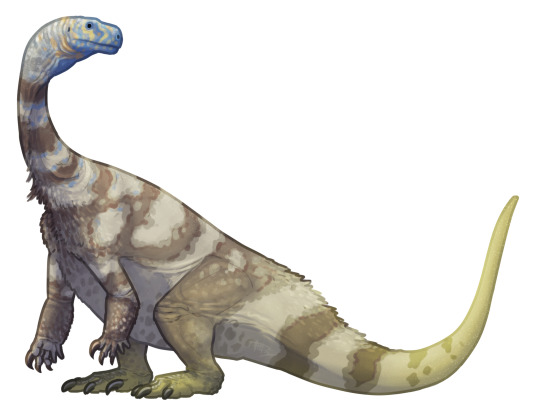
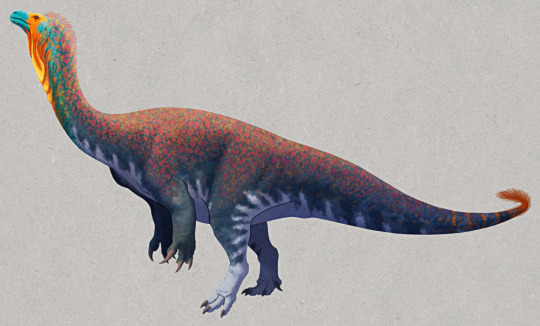
Factfiles:
Ngwevu ntoloko

Artwork by @i-draws-dinosaurs, written by @i-draws-dinosaurs and @zygodactylus
Name meaning: Grey skull
Time: ~190 to 180 million years ago (Pliensbachian to Toarcian stages of the Early Jurassic)
Location: Clarens Formation, South Africa
Ngwevu is a dinosaur with a case of baby-face so bad it was classified as another genus for 40 years. Initially discovered in 1978 and thought to be a specimen of Massospondylus, turns out it was just a really baby-looking prosauropod of a different kind! Many times in evolution animals will retain “baby” characteristics into adulthood - the classic and easily recognizable trait being large, round eyes, but also other features such as stunted proportions and chunkier limbs, depending. It seems that Ngwevu went through one of these processes, looking more similar to juveniles of other prosauropods (such as Massospondylus) than adults, all while actually being adults themselves. Predictably, it had a squat face with large eyes, a wide snout, robust proportions, and a thick body - babified Massospondylus! It probably had a more generalist diet than its cousin, indicating probable niche partitioning as the two lived in the same environment. The Clarens Formation, coming right after the Elliot, was an arid desert dominated by dunes, with a few types of dinosaurs including ornithischians, theropods, and other sauropodomorphs. In addition, fish, crustaceans, and invertebrates are also known from this location.
Kholumolumo ellenbergerorum

Artwork by @alphynix, written by @i-draws-dinosaurs
Name meaning: Kholumolumo (giant reptilian dragon from Sotho folklore) named for Paul and François Ellenberger (the original excavators of the fossils)
Time: 210 million years ago (Norian stage of the Late Triassic)
Location: Lower Elliot Formation, Lesotho
Kholumolumo is an old friend with a new name. Its previous informal name, “Thotobolosaurus” meaning “trash heap reptile”, was truly magnificent and became one of the great memes of Ye Olde 2010s Palaeo Tumblr! Needless to say it was a bittersweet moment to see our old buddy finally published but lose its iconic name in the process. Rest in peace, Trash Heap Lizard.
The reason it wound up with that name is because the fossils were in fact found basically right next to the local rubbish dump of the village of Maphutseng in 1955. The trash pile turned out to be sitting on a bone bed of around five to ten animals, and over the course of several years they were excavated and moved to the University of Cape Town. Unfortunately, and perhaps appropriately to the name, the subsequent study of these fossils ended up being a complete trash fire. Specimens went missing that have never been found, professional relationships fell apart, and the animal itself wasn’t mentioned in the literature until 1970 when it was dropped into a discussion on the stratigraphy of the Elliot formation and named “Thotobolosaurus mabeatae” without any description of the fossils. This made the name “Thotobolosaurus” a nomen nudum (naked name) and thus invalid.
Finally in 2020 all the tribulation paid off and it received a proper initial description, although many fossils that weren’t lost in the chaos still remain under study and could be the subject of future papers. It’s nice to see our beloved trash heap of a dinosaur finally coming into its own!
DMM Round One Masterpost
#dmm#dinosaur march madness#dmm round one#dmm rising stars#palaeoblr#dinosaurs#paleontology#bracket#march madness#polls#ngwevu#kholumalumo
172 notes
·
View notes
Text
Dactylioceras sp. (Ammonite)







BB-F-0029
Location: Forchheim, Oberfranken, Bayern, Germany
210x221x66 mm / 3037g (Large Cabinet)
Species: Dactylioceras sp.
Genus: Dactylioceras
Order: Ammonitida
Class: Cephalopoda
Age: Toarcian
Epoch: Lower-Jurassic
Period: Jurassic
Era: Mesozoic
0 notes
Photo
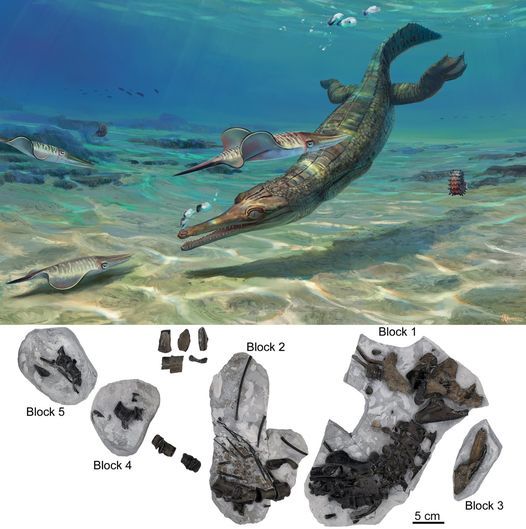
A new early diverging thalattosuchian (Crocodylomorpha) from the Early Jurassic (Pliensbachian) of Dorset, U.K. and implications for the origin and evolution of the group
Eric W. Wilberg,Pedro L. Godoy,Elizabeth F. Griffiths,Alan H. Turner &Roger B. J. Benson
ABSTRACT
Among archosaurs, thalattosuchian crocodylomorphs experienced the most extensive adaptations to the marine realm. Despite significant attention, the phylogenetic position of the group remains uncertain. Thalattosuchians are either the sister-group to Crocodyliformes, basal mesoeucrocodylians, or nest among longirostrine neosuchians.
The earliest definite thalattosuchians are Toarcian, and already possess many synapomorphies of the group. All phylogenetic hypotheses imply a ghost lineage extending at least to the Sinemurian, and a lack of older or more plesiomorphic forms may contribute to the uncertain phylogenetic placement of the group.
Here we describe a new species, Turnersuchus hingleyae, gen. et sp. nov., from the early Pliensbachian Belemnite Marl Member of the Charmouth Mudstone Formation (Dorset, U.K.). The specimen includes partially articulated cranial, mandibular, axial, and appendicular elements. It can be attributed to Thalattosuchia based on the following features: distinct fossa on the posterolateral corner of the squamosal; broad ventrolateral process of the otoccipital covering the dorsal surface of the quadrate; large supratemporal fenestrae lacking a flattened skull table; broadly exposed prootic; orbital process of quadrate lacking bony attachment with the braincase. This specimen represents the earliest thalattosuchian currently known from diagnostic material.
Phylogenetic analyses of two published datasets recover Turnersuchus as the earliest diverging thalattosuchian, and sister to Teleosauroidea + Metriorhynchoidea. Bayesian tip-dating analyses suggest a Rhaetian or Sinemurian divergence of Thalattosuchia from other crocodylomorphs, depending on topology, with confidence intervals spanning from the Norian to the Pliensbachian.
The new specimen extends the fossil record of Thalattosuchia, but the time-scaling analyses demonstrate that a significant ghost lineage remains.
Read the paper here:
https://www.tandfonline.com/doi/abs/10.1080/02724634.2022.2161909
23 notes
·
View notes
Text
Carpet sharks are sharks classified in the order Orectolobiformes /ɒrɛkˈtɒləbɪfɔːrmiːz/. Sometimes the common name "carpet shark" (named so because many species resemble ornately patterned carpets) is used interchangeably with "wobbegong", which is the common name of sharks in the family Orectolobidae. Carpet sharks have five gill slits, two spineless dorsal fins, and a small mouth that does not extend past the eyes. Many species have barbels.
The carpet sharks are a diverse group of sharks with differing sizes, appearances, diets, and habits. They first appeared in the fossil record in the Early Jurassic; the oldest known orectolobiform genera are Folipistrix (known from Toarcian to Aalenian of Belgium and Germany), Palaeobrachaelurus (Aalenian to Barremian) and Annea (Toarcian to Bajocian of Europe).[1] All species have two dorsal fins and a relatively short, transverse mouth that does not extend behind the eyes. Besides the nostrils are barbels, tactile sensory organs, and grooves known as nasoral grooves connect the nostrils to the mouth. Five short gill slits are just in front of the origin of the pectoral fin and the fifth slit tends to overlap the fourth one.[2] A spiracle occurs beneath each eye which is used in respiration. The only exception to this rule is the whale shark, the spiracles of which are situated just behind the eyes.[3] Carpet sharks derive their common name from the fact that many species have a mottled appearance with intricate patterns reminiscent of carpet designs. The patterning provides camouflage when the fish is lying on the seabed.[4] The largest carpet shark is the whale shark (Rhincodon typus) which can grow to a length of 14 m (46 ft). It is the largest species of fish, but despite its size, is not dangerous, as it is a filter feeder, drawing in water through its wide mouth and sifting out the plankton. The smallest carpet shark, at up to about 30 cm (12 in) long, is the barbelthroat carpet shark, (Cirrhoscyllium expolitum).[3] Some of the most spectacularly coloured members of the order are the necklace carpet shark (Parascyllium variolatum), the zebra shark (Stegostoma fasciatum), and the ornate wobbegong (Orectolobus ornatus). Nurse sharks and whale sharks have a fringe of barbels on their snouts, and barbelthroat carpet sharks (Cirrhoscyllium expolitum) have barbels dangling from their throat regions
@remen-nyoodless @chartreuse-blood
12 notes
·
View notes
Text
Fossilized Fish Found in Cattle Field
The fossilised remains of a Pachycormus fish (below) have been found in a cattle field in Stroud, Gloucestershire.
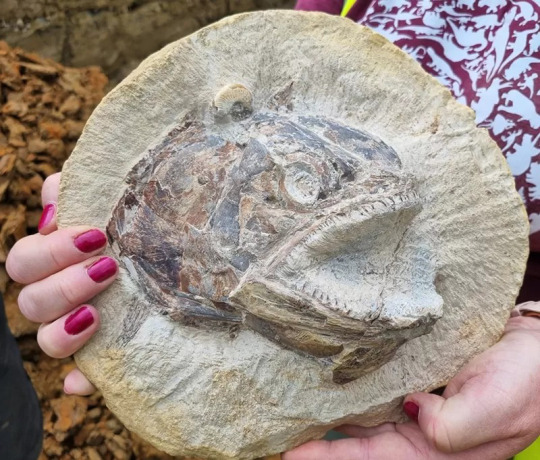
Found by Nevile and Sally Hollingworth (who are both noted for their exceptional ability to identify high return fossil areas) in a rich fossil seam running through a famers field, the fossil dates back 183 million years, a time when the land would have been submerged under tropical waters, known as the Toarcian stage of the Jurassic. This period of time is known for its excellent preservation of soft tissues.
Several more fossils were found in the same seam, including more fish, squids, and two ichthyosaurs. This is interesting as its a prime example of the full food chain. More interestingly, fossilised wood and insects have also been found in the seam, suggesting that land was close by.
The last time a comparable site was found was the Strawberry Bank Langerstatte in Somerset during the 1800's, marking an exciting step forward in the study of the Jurassic period.
Source (of information and image): BBC News, written by Jonathan Amos
2 notes
·
View notes
Photo


Meine Fossilien-Sammlung | My fossil collection
[54]
Pyritisierter Belemnit | Pyritized belemnite
Acrocoelithes sp.
Unterer Jura, Toarcium (vor 183,0 - 175,6 Mio Jahren)
Lower Jurassic, Toarcian (183,0 - 175,6 mya)
Posidonienschiefer, Balingen | Posidonia shale, Balingen
2 notes
·
View notes
Text
Perijasaurus lapaz Rincón et al., 2022 (new genus and species)

(Part of the type vertebra of Perijasaurus lapaz, with broken regions in orange and reconstructed regions or surrounding rock in yellow, from Rincón et al., 2022)
Meaning of name: Perijasaurus = Serranía del Perijá lizard [in Greek]; lapaz = La Paz [town near where the original fossil was discovered]
Age: Early or Middle Jurassic (Toarcian or Aalenian)
Where found: La Quinta Formation, Cesar, Colombia
How much is known: A single back vertebra.
Notes: Perijasaurus was an early sauropod, known from closer to the Equator than any other Early or Middle Jurassic sauropod. The type specimen of this dinosaur had been previously described in 1955, but was left unnamed at the time. Following a reexamination of the fossil, the authors of a new study gave it a name and reinterpreted it in light of what is now known about sauropod diversity. The only known vertebra of Perijasaurus is not as extensively hollow as those of later sauropods, suggesting that it represents an intermediate stage in the evolution of weight-saving features in sauropod vertebrae.
Reference: Rincón, A.F., D.A. Raad Pájaro, H.F. Jiménez Velandia, M.D. Ezcurra, and J.A. Wilson Mantilla. 2022. A sauropod from the Lower Jurassic La Quinta Formation (Dept. Cesar, Colombia) and the initial diversification of eusauropods at low latitudes. Journal of Vertebrate Paleontology advance online publication. doi: 10.1080/02724634.2021.2077112
#Palaeoblr#Dinosaurs#Perijasaurus#Early Jurassic#Middle Jurassic#South America#Sauropoda#2022#Extinct
25 notes
·
View notes
Photo

A warning from the past
Trying to assess the likely effects of the upcoming changes in climate on the diverse ecosystems of the globe is a tricky business, since, unlike our ancestors who saw the end of the ice age and its widespread impacts, we have no direct experience of such events. The clearest lessons we can infer come from the geological record of times past in which similar conditions to those expected in our future occurred.
One commonly discussed event is the sudden abrupt warming associated with the Paleocene Eocene thermal maximum (seehttp://tinyurl.com/povhewl andhttp://tinyurl.com/qfqtkc4), but new research based on fieldwork along the coast of Yorkshire in England has given us an older analogue in the deeper past, analysing the effect of events similar to those that may be coming on marine ecosystems 180 million years ago in the early Jurassic.
The event saw global warming, gradual oxygen depletion in the seas, and an accompanying marine extinction event (which we already discussed in relation to the gem jet which is found in the dead zone of black shale that marks the extinction, seehttp://tinyurl.com/m99r5ag) that wiped out a quarted of all marine organisms.
The team correlated detailed stratigraphic (ie layer by layer) fossil counts through the period covering the extinction, gleaning further detailed environmental information from both sedimentology and geochemistry on the conditions under which the sediments (and their enclosed fossils) were deposited. They also correlated their field data with published information on ancient ocean temperatures, oxygen levels and sea level.
The results revealed drastic changes to ecosystems, and that while the seas eventually recovered, the new ecological networks that returned were quite different to their predecessors. They conclude from the changing environmental conditions they encountered through the different layers of rock and the story that they revealed that if global warming becomes too severe and long lasting, a marine extinction is likely and we cannot predict what will replace the vanished ecosystems.
This most detailed analysis of the Toarcian event shows how the ecosystems changed in response to the changes in conditions that had already been inferred from earlier studies. It seems like the response echoed that of modern marine life forms confronted with lowered oxygen levels. Though the species are different, similar patterns and ecological stages were found.
Marine ecosystems are already under threat, and not just from warming. Ocean acidification (also linked to CO2 emissions) and habitat pressure are already wreaking havoc amongst coral ecosystems worldwide, and the warming looks like it is going to add several further stresses to the delicate and balanced structures that life forms in the seas of the world. It would be a crying shame to see the past of the Toarcian repeat itself, knowing what we now do, and still (just about) in a position to change our ways, however painful that may prove.
Loz
Image credit, nacreous iridescent ammonites in Jurassic shale from the UK: Cobalt123
http://www.timesofmalta.com/articles/view/20130221/environment/Ocean-life-is-under-threat.458514 http://www.plymouth.ac.uk/pages/view.asp?page=39880 Original paper, free access: http://www.plosone.org/article/info%3Adoi/10.1371/journal.pone.0056255
137 notes
·
View notes
Photo

Prehistoric reptile pregnant with octuplets
Palaeontologists have discovered part of the skeleton of a 180 million-year-old pregnant ichthyosaur with the remains of between six and eight tiny embryos between its ribs.
The new specimen was studied by palaeontologists Mike Boyd and Dean Lomax from The University of Manchester. It was collected around 2010 from near Whitby, North Yorkshire and is from the Early Jurassic. The fossil was in the collection of fossil collector, Martin Rigby, who thought the specimen might be a block of embryos. Dean confirmed the suspicion and the specimen was acquired by the Yorkshire Museum, York.
Ichthyosaurs were aquatic reptiles that dominated the Jurassic seas. They gave birth to live young, rather than laying eggs, and did not need to return to land, even to breed. They were carnivores, feeding upon other reptiles, fish, and marine invertebrates such as the squid-like belemnites.
Ichthyosaur fossils are quite common in the UK and often found in British Jurassic rocks. However, only five ichthyosaur specimens from Britain have ever been found with embryos and none with this many.
Boyd, M. J. and Lomax, D. R. The youngest occurrence of ichthyosaur embryos in the UK: A new specimen from the Early Jurassic (Toarcian) of Yorkshire. Proceedings of the Yorkshire Geological Society, 2018 DOI: 10.1144/pygs2017-008
Image of pregnant ichthyosaur with octuplets.Credit: Copyright Nobumichi Tamura
167 notes
·
View notes
Text
'Never seen anything like it': Impeccably preserved Jurassic fish fossils found on UK farm


A farm in England was the unlikely source of a Jurassic jackpot: a treasure trove of 183 million-year-old fossils. On the outskirts of Gloucestershire in the Cotswolds, beneath soil that is currently trampled under the hooves of grazing cattle, researchers recently uncovered the fossilized remains of fish, giant marine reptiles called ichthyosaurs, squids, insects and other ancient animals dating to the early part of the Jurassic period (201.3 million to 145 million years ago).
Of the more than 180 fossils logged during the dig, one of the standout specimens was a three-dimensionally preserved fish head that belonged to Pachycormus, an extinct genus of ray-finned fishes. The fossil, which researchers found embedded in a hardened limestone nodule poking out of the clay, was exceptionally well preserved and contained soft tissues, including scales and an eye. The 3D nature of the pose of the specimen’s head and body was such that the researchers couldn’t compare it to any other previous find.
“The closest analogue we could think of was Big Mouth Billy Bass,” said Neville Hollingworth, a field geologist with the University of Birmingham who discovered the site with his wife, Sally, a fossil preparator and the dig’s coordinator. “The eyeball and socket were well preserved. Usually, with fossils, they’re lying flat. But in this case, it was preserved in more than one dimension, and it looks like the fish is leaping out of the rock,” Hollingworth told Live Science.
A fish’s scales and eyes were some of the soft tissues preserved for more than 180 million years. (Image credit: Dean Lomax)
“I’ve never seen anything like it before,” Sally Hollingworth added. “You could see the scales, skin, spine — even its eyeball is still there.”
The sight astounded the Hollingworths so much that they contacted ThinkSee3D, a company that creates digital 3D models of fossils, to create an (opens in new tab)interactive 3D image (opens in new tab) of the fish to help bring it to life and to allow researchers to study it more closely.
Related: Enormous graveyard of alien-like sea creatures discovered at ‘Jurassic Pompeii’ in central UK
Most of the fossils the Hollingworths and a team of scientists and specialists unearthed were located behind the farm’s cowshed. (The farm is home to a herd of English longhorn — a British breed of beef cattle with long, curved horns — many of which kept a close eye on the excavation.)
“It was a bit unnerving digging when you’re being watched by a herd of longhorn,” Sally Hollingworth told Live Science.
At one time, this region of the United Kingdom was completely submerged by a shallow, tropical sea, and the sediments there likely helped preserve the fossils; Neville Hollingworth described the Jurassic beds as slightly horizontal, with layers of soft clays under a shell of harder limestone beds.
“When the fish died, they sank to the bottom of the seabed,” said fossil marine reptile specialist Dean Lomax, a visiting scientist at the University of Manchester in the U.K. and a member of the excavation group. “As with other fossils, the minerals from the surrounding seabed continually replaced the original structure of the bones and teeth. In this case, the site shows that there was very little to no scavenging, so they must’ve been rapidly buried by the sediment. As soon as they hit the seabed, they were covered over and protected immediately.”
During the four-day dig earlier this month, the eight-person team used a digger to excavate 262 feet (80 meters) across the farm’s grassy banks, “pulling back layers to reveal a small slice of geological time,” Neville Hollingworth said. A number of diverse specimens dated to the Toarcian age (a stage of the Jurassic that occurred between 183 million and 174 million years ago) and included belemnites (extinct squid-like cephalopods), ammonites (extinct shelled cephalopods), bivalves and snails, in addition to fish and other marine animals.
“It’s important that we can compare these fossils with other Toarcian age fossil sites, not only in the U.K. but also across Europe and potentially sites in America,” Lomax said. He pointed to Strawberry Bank Lagerstätte, an early Jurassic site in southern England, as one such example.
The group plans to continue studying the specimens and is working toward publishing the findings. Meanwhile, a selection of the fossils will be placed on display at the Museum in the Park in Stroud.
Originally published on Live Science.
New post published on: https://livescience.tech/2022/07/29/never-seen-anything-like-it-impeccably-preserved-jurassic-fish-fossils-found-on-uk-farm/
1 note
·
View note
Text
Asfaltovenator vs Meraxes
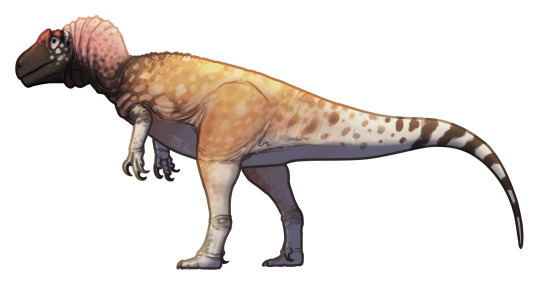
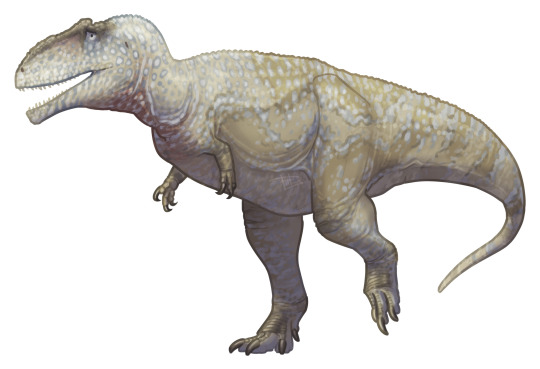
Factfiles:
Asfaltovenator vialidadi

Artwork by @i-draws-dinosaurs, written by @raptorcivilization
Name meaning: Hunter of the Cañadón Asfalto Formation, thanks to the Vialidad Nacional
Time: 179 to 178 million years ago (Toarcian stage of the Early Jurassic)
Location: Cañadón Asfalto Formation, Argentina
On the surface Asfaltovenator might look like just a generic carnosaur. Which it kinda is - being at around the base of Carnosauria. But it’s a pretty good basal carnosaur. It’s known from a single individual, but the entire front half of the body was recovered - complete head, neck, arms, and torso. Which is pretty cool. What’s even more interesting is that it displays a blend of anatomical features that had previously been considered unique to different tetanuran lineages (megalosauroids, carnosaurs, and coelurosaurs). Because of this, in the the phylogenetic analysis from its description, it dragged megalosauroids back into Carnosauria. First time that happened in a couple decades, which is neat. It even kinda looks like a retro carnosaur, in my opinion at least. At an estimated 25 feet long, while not huge, it was one of the largest predatory dinosaurs on the planet at the time. It lived alongside other early members of diverse Jurassic-Cretaceous dinosaur groups, including Eoabelisaurus, Bagualia, and Volkheimeria, as well as several mammals, a rhynchocephalian, the hallopodid crocodylomorph Almadasuchus, turtles, frogs, and the pterosaur Allkaruen.
Meraxes gigas

Artwork by @i-draws-dinosaurs, written by @zygodactylus
Name Meaning: Giant Dragon
Time: 95 million years ago (Cenomanian stage of the Late Cretaceous)
Location: Huincul Formation, Patagonia, Argentina
Giganotosaurs keep having new family members added to the group, and this one, Meraxes, is actually known from a decent amount of fossil material! Woo! Raching tern meters in length and known from parts of the limb bones, the skull, ribs, and vertebrae that show Meraxes was very similar to other Carcharodontosaurs, such as Acrocanthosaurus, in terms of limb proportions. It had the shortened forelimbs similar to other large carnivorous dinosaurs, indicating that this trait was selected for in large theropods on a repeated basis. It had a huge claw on its second toe, twice as long as the fourth toe claw. Having died sometime between 39 and 53 years of age, Meraxes is also one of the longest-lived nonavian theropods known, extending its growth period through its life in order to grow to larger sizes. Living in the arid, seasonal floodplain environment of the Huincul Formation, Meraxes lived alongside a wide variety of other dinosaurs, including Argentinosaurus, Cathartesaura, Choconosaurus, Chucarosaurus, Limaysaurus, Taurovenator, Mapusaurus, Gaulicho, Aoniraptor, Skorpiovenator, Tralkasaurus, Ilokelesia, Huinculsaurus, Overoraptor, and other fragmentary taxa.
DMM Round One Masterpost
#dmm#dinosaur march madness#dmm round one#dmm rising stars#palaeoblr#dinosaurs#paleontology#bracket#march madness#polls#asfaltoveantor#meraxes
129 notes
·
View notes
Text
"Taffertia is an extinct genus of cephalopod belonging to the family Hildoceratidae. These cephalopods existed in the Jurassic period, during Toarcian age in the Falciferum zone and possibly only in Exaratum subzone. Its fossils were found in Canada, Morocco, Algeria and Italy"
thanks gr8
writing tip #3195:
your next novel should be about the first thing that comes up on wikiroulette
92 notes
·
View notes